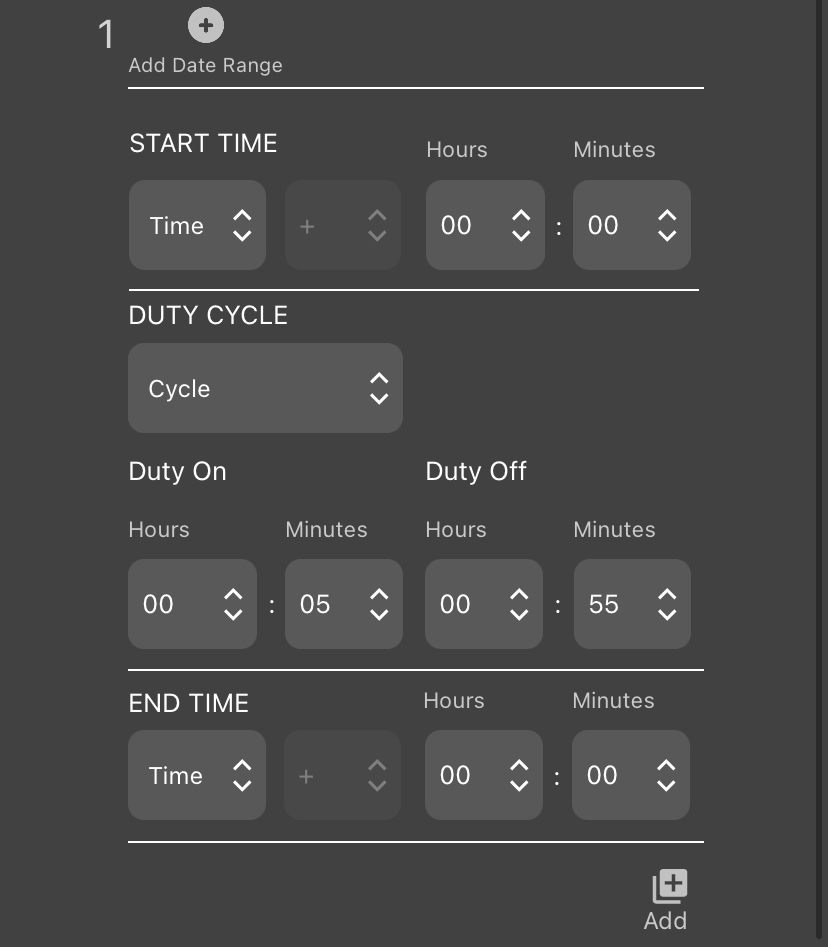Schedules and Schedule Blocks
A schedule for the Song Meter Micro 2 can be made up of up to ten schedule blocks. If a schedule block were just a single recording period, having only ten would be severely limiting. For instance, let's say you want to capture a short snapshot of a soundscape over the course of each day by recording five minutes at the start of every hour. If a schedule block only provided one recording period, you would need to tediously punch in separate start and end dates, and then you would run out before you even recorded half of your snapshots!
Luckily, this type of schedule can be programmed with just one schedule block:
Example: Record Five Minutes Every Hour

For accessibility and ease of reading on multiple screen sizes, further examples will only present schedules as plain text. The text below mimics the commands shown in the screenshot above.
-
START TIME: Time 00:00
-
DUTY CYCLE: Cycle
-
Duty On: 00:05
-
Duty Off: 00:55
-
-
END TIME: Time 00:00
With five simple commands, this one schedule block has told the Song Meter Micro 2 to record five minutes at the start of each hour. The following sections expand on how each component works.
This example does not use the optional Date Range feature. This means that, as soon as the recorder starts its schedule, this schedule block will perform the same thing every day. We'll cover the capabilities of Date Range in a later section.
Start Time and End Time
-
START TIME: Time 00:00
-
...
-
END TIME: Time 00:00
The START TIME and END TIME commands are best understood in relation to each other. Everything the schedule block does occurs after the START TIME and continues until it reaches the END TIME. This is the case even when the START TIME and END TIME share the same value, as they do here. The schedule block will begin every time it reaches 00:00 (12:00 AM on the 12-hour clock) and it will do whatever you program it to do until it reaches the next 00:00. Each midnight, the recorder will simultaneously end one cycle of this schedule block and start a new one.
This same logic means that a single schedule block can span two calendar dates:
-
START TIME: Time 17:00
-
...
-
END TIME: Time 05:00
In this example, the schedule block will start running every time the clock hits 17:00 (5:00 PM) and will end the next time the clock hits 05:00 (5:00 AM), which will be the next day.
While this may seem obvious, understanding this now is important for when we later introduce START TIMES and END TIMES set relative to sunrise and sunset.
When you start your deployment for the first time, the Song Meter Micro 2 will pick up in the middle of any schedule block that should be occurring at that time. The recorder does not need to wait for the next occurrence of the START TIME when it turns on.
Duty Cycle
In the engineering world, "duty cycle" describes a pattern of repeating activity and inactivity. This could be a pattern of "on" and "off" signals in a computer that alternate millions of times per second, or it could be a schedule whereby a manufacturing machine is run for three hours every day.
In Song Meter schedules, a duty cycle tells the recorder to alternate between recording and sleeping, at fixed time intervals, in between the START TIME and END TIME.
When DUTY CYCLE is enabled by selecting Cycle, the schedule block will begin at the START TIME by recording, then it will pause, then it will record, then it will pause, repeating this until the END TIME is reached.
Returning to our "Record 5 minutes every hour" example, the DUTY CYCLE section of the schedule block is:
-
DUTY CYCLE: Cycle
-
Duty On: 00:05
-
Duty Off: 00:55
-
At the START TIME, the recorder begins at the Duty On phase by recording for five minutes. Then, it runs the Duty Off phase by sleeping for 55 minutes. It will alternate between five minutes of recording and 55 minutes of sleeping for as many time as it takes to reach the END TIME.
The END TIME will immediately end the schedule block in the middle of either the Duty On or Duty Off phase. If the time span between the START TIME and END TIME is short enough, it is possible to end a schedule block before the recorder can complete a single cycle.
